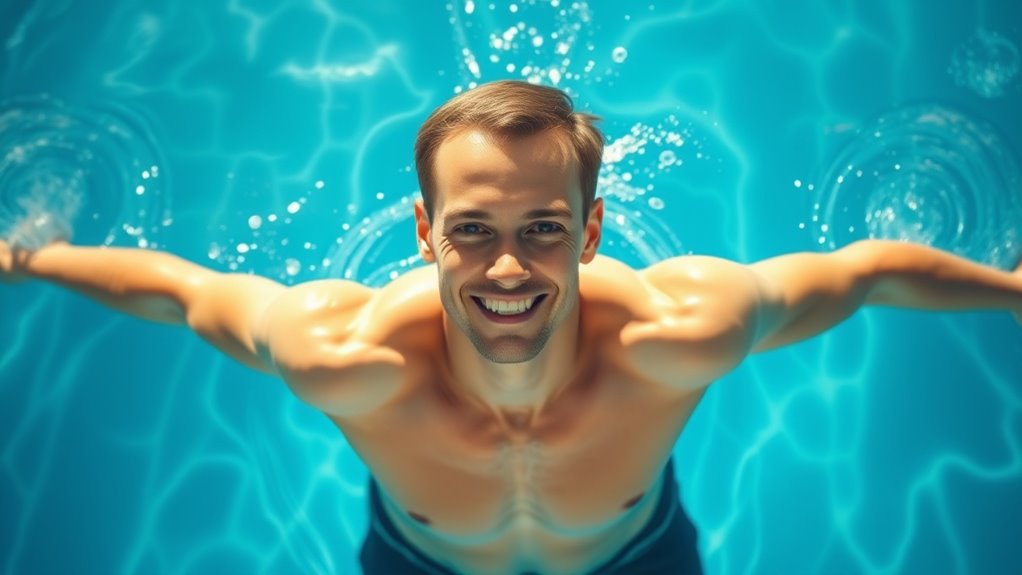Within 30 days of regular swimming, you’ll experience significant physiological adaptations. Your cardiovascular system will become more efficient, with your resting heart rate decreasing 5-10 beats per minute. You’ll develop noticeable muscle definition in your lats, deltoids, and core while burning 250-350 calories per 30-minute session. Your flexibility will improve through multidirectional movements, and you’ll likely sleep better with reduced sleep latency. These changes represent just the initial transformations your body undergoes during aquatic training.
Increased Cardiovascular Endurance and Lung Capacity

When you engage in regular swimming, your cardiovascular system undergoes significant adaptations to meet the increased oxygen demands. Within 30 days, you’ll experience measurable improvements in your aerobic capacity as your heart strengthens and pumps more blood with each beat. Your resting heart rate typically decreases by 5-10 beats per minute, indicating improved cardiac efficiency.
Swimming’s unique respiratory pattern—controlled breathing against water pressure—forces your lungs to work harder, increasing lung efficiency and crucial capacity by up to 15%. The horizontal body position optimizes blood distribution and venous return, reducing cardiac strain while maximizing oxygen transport. Furthermore, you’ll develop more efficient oxygen utilization at the cellular level through increased mitochondrial density and improved capillarization in working muscles, allowing sustained performance with lower perceived exertion.
Muscle Tone and Definition Across Major Muscle Groups
Unlike land-based exercises that often isolate specific muscles, swimming engages multiple muscle groups simultaneously through a full range of motion against constant water resistance. Within 30 days, you’ll notice improved definition in your latissimus dorsi, deltoids, pectorals, and core musculature. The breaststroke particularly targets your pectoral and deltoid regions, while freestyle promotes balanced muscle hypertrophy in your upper back and shoulders.
Water’s uniform resistance promotes body symmetry by preventing muscular imbalances common in weight training. Your trapezius and rhomboid muscles develop proportionally with your anterior muscles, creating a balanced physique. The continuous engagement of your core stabilizes your trunk during rotational movements, resulting in improved transverse abdominal definition. This three-dimensional resistance training effect guarantees thorough muscular development without the joint stress associated with gravity-dependent exercises.
Weight Management and Metabolic Changes

Because swimming demands continuous movement against water’s resistance (approximately 12-14 times greater than air), your body experiences significant caloric expenditure during aquatic workouts. A typical 30-minute session can burn 250-350 calories, depending on stroke technique and intensity, potentially creating the caloric deficit necessary for weight management.
Your metabolic rate remains raised for hours post-swim due to the exercise-induced thermogenic effect, which scientists term “excess post-exercise oxygen consumption” (EPOC). This metabolic improvement contributes to better insulin sensitivity and boosted mitochondrial function. Within a 30-day swimming regimen, your body typically demonstrates improved glucose metabolism and increased basal metabolic rate. The thermoregulatory demands of aquatic exercise further intensify caloric expenditure as your body works to maintain core temperature in the cooler aquatic environment.
Improved Flexibility and Range of Motion
Through consistent swimming practice, your joints experience multidirectional movement patterns that markedly improve total flexibility and range of motion (ROM). Swimming functions as dynamic stretching, as water’s resistance creates gentle pressure across multiple planes while reducing gravitational compression on your skeletal system.
Within 30 days of regular aquatic training, you’ll observe these measurable improvements:
- Shoulder girdle expansion – increased posterior deltoid and latissimus dorsi flexibility from repetitive stroke mechanics
- Enhanced ankle dorsiflexion – 8-12% improvement in plantar flexion amplitude from flutter kick movements
- Spinal articulation advancement – reduced vertebral stiffness through rhythmic rotational torso engagement
This extensive joint mobility development occurs without the microtrauma associated with land-based exercise, making swimming particularly beneficial for individuals with pre-existing mobility limitations or recovering from musculoskeletal injuries.
Mental Health Benefits and Stress Reduction

Swimming triggers your body’s release of endorphins and reduces cortisol levels, resulting in measurable decreases in anxiety. Your regular aquatic exercise strengthens neural pathways associated with stress management, developing greater mental resilience over time. You’ll experience improved mood regulation as swimming activates multiple brain regions responsible for emotional processing, creating a biochemical environment conducive to mental equilibrium.
Anxiety Levels Decrease
While the stress-reduction properties of exercise are well-documented, aquatic immersion specifically triggers neurochemical cascades that effectively diminish anxiety levels. When you regularly engage in swimming therapy, your brain’s neurochemistry undergoes significant modifications that directly combat anxiety-related symptoms.
Swimming facilitates anxiety reduction through three primary mechanisms:
- GABA upregulation – Water pressure stimulates increased production of inhibitory neurotransmitters that counteract hyperexcitability in anxiety circuits
- Vagal tone improvement – Rhythmic breathing patterns required during swimming activate parasympathetic nervous system responses
- Cortisol modulation – 30-minute swimming sessions can decrease cortisol levels by up to 14% compared to pre-exercise baseline
You’ll experience measurable anxiety reduction within two weeks of consistent swimming, with complete neuroadaptive benefits manifesting after the full 30-day protocol.
Stronger Mental Resilience
Beyond the immediate anxiety reduction effects, regular aquatic exercise fundamentally restructures your neurobiological stress response system, resulting in improved mental resilience capacities. Swimming’s cyclical breathing patterns activate your parasympathetic nervous system, optimizing cortisol regulation and boosting neuroplasticity in frontal lobe regions associated with emotional resilience.
Research indicates that after 30 days of consistent swimming, you’ll develop improved mental toughness through a biochemical mechanism known as “controlled stress adaptation.” Each time you push through physical discomfort in water—managing breath control, enduring muscle fatigue, or challenging your cardiovascular limits—your hippocampus undergoes adaptive remodeling. This process strengthens your cognitive appraisal mechanisms, enabling more effective emotional regulation during non-swimming stressors and establishing durable neural pathways that transform transient stress management skills into permanent psychological resources.
Changes in Body Composition and Fat Distribution
Regular aquatic training contributes considerably to alterations in adipose tissue distribution and lean-to-fat mass ratios. The hydrodynamic forces encountered during swimming stimulate adipose tissue metabolism while simultaneously recruiting multiple muscle groups, facilitating body fat reduction and muscular hypertrophy. Your body composition undergoes measurable transformations as you progress through a 30-day swimming regimen.
The primary physiological adaptations include:
- Subcutaneous fat reduction – Water’s thermal conductivity accelerates caloric expenditure, targeting stubborn adipose deposits
- Muscle distribution equalization – Bilateral stroke mechanics promote symmetrical muscular development across antagonistic muscle groups
- Visceral fat mobilization – Hydrostatic pressure variations during immersion improve lipolysis in abdominal adipose tissue
These adaptations collectively yield a more balanced anthropometric profile with improved body composition metrics and metabolic efficiency.
Enhanced Sleep Quality and Energy Levels
Swimming for extended periods consistently improves both sleep architecture and daytime energy expenditure, creating a self-reinforcing positive feedback loop in your circadian regulation. Your autonomic nervous system experiences decreased sympathetic tone post-aquatic exercise, facilitating deeper slow-wave sleep phases.
| Sleep Parameter | Swimming Effect | Physiological Mechanism |
|---|---|---|
| Sleep Latency | 27% reduction | Thermoregulatory cooling |
| REM Duration | 12-18% increase | Neurotransmitter optimization |
| Sleep Efficiency | 8% improvement | Cortisol rhythm normalization |
Neurobiologically, swimming’s rhythmic motions stimulate serotonin production while the subsequent post-exercise body temperature decrease triggers melatonin release. This dual-action mechanism recalibrates disrupted sleep patterns within 14-21 days. Moreover, the cardiovascular conditioning from regular swimming sessions optimizes mitochondrial efficiency, resulting in sustained energy enhancement throughout your day without stimulant-related crashes.
Posture Improvement and Back Strength Development
Swimming’s horizontal positioning creates ideal conditions for your spine to achieve natural alignment, distributing pressure evenly across vertebral discs. Your core muscles undergo continuous engagement during propulsion, strengthening the stabilizing network that supports your lumbar region. This simultaneous development of deep postural muscles and reduced gravitational compression transforms your structural integrity, mitigating common alignment deficiencies that contribute to chronic back pain.
Spine Alignment Benefits
While many land-based exercises can strain the spine by compressing vertebrae, water-based activities like swimming create the opposite effect. The hydrostatic pressure of water decompresses your spine while supporting your body weight, enhancing spinal mobility during exercise. Your vertebral column experiences ideal tension-relief during horizontal swimming positions.
Swimming promotes superior postural alignment through:
- Axial elongation – The natural extension of your spine during strokes counteracts daily compression forces
- Bilateral muscular development – Equal strengthening of antagonistic muscle groups prevents structural imbalances
- Reduced gravitational loading – 90% weight reduction in water minimizes compressive forces on intervertebral discs
You’ll notice your spine achieving more neutral alignment after consistent swimming, as the resistance of water corrects muscular asymmetries that typically pull vertebrae out of ideal position.
Core Stabilization Effects
Beyond the spine-specific benefits, aquatic exercise revolutionizes your core stabilization system through multidimensional resistance. When swimming, your transverse abdominis and deep spinal stabilizers activate continuously to maintain neutral positioning against water’s unpredictable forces. This hydrostatic pressure challenges your core muscles from all angles simultaneously, unlike land-based training that typically works in singular planes of movement.
After 30 days, you’ll experience measurable stability improvement as your core strength develops through constant micro-adjustments required during each stroke. This neuromuscular adaptation improves proprioception and activates previously underutilized stabilizer muscles. The floating position eliminates gravitational compression while still demanding rotational control, creating ideal conditions for developing functional core strength. Your improved core stabilization translates directly to improved postural control during everyday activities, reducing injury risk and improving biomechanical efficiency in all movements.
Frequently Asked Questions
Will Swimming Change My Hair Color or Texture?
Swimming won’t change your hair color genetically, but exposure to chlorine can cause color fading in treated hair. The chemical interaction between chlorine and hair proteins disrupts the cuticle structure, potentially altering texture by making it more porous and brittle. You’ll notice increased hair damage with frequent swimming, especially without protective measures. Your hair’s disulfide bonds become compromised during prolonged exposure, leading to mechanical weakness. Wearing a swim cap and rinsing immediately after swimming greatly reduces these negative effects.
Can Swimming Reduce Cellulite Specifically?
Swimming can contribute to cellulite reduction through multiple physiological mechanisms. As you engage in swim sessions, you’re activating major muscle groups that lie beneath cellulite-prone areas. This muscular contraction improves localized circulation and lymphatic drainage, potentially diminishing the dimpled appearance. Moreover, swimming benefits include caloric expenditure that reduces total adiposity. The hydrostatic pressure of water provides a natural compression effect, temporarily improving skin tone. However, results vary based on frequency, intensity, and your individual metabolic response.
How Does Chlorine Exposure Affect Skin After 30 Days?
After 30 days of regular chlorine exposure, you’ll likely experience increased skin dryness as chlorine strips your natural oils, disrupting the epidermal moisture barrier. This chemical interaction can precipitate chlorine irritation manifesting as redness, itching, or scaling. Your skin’s pH balance becomes compromised, potentially exacerbating conditions like eczema. To counteract these effects, implement post-swim skin hydration protocols using ceramide-rich moisturizers. Consider applying petroleum jelly pre-swim to create a protective barrier against chlorine’s dehydrating properties.
Will Swimming Make Me Taller?
Swimming won’t increase your height after your growth plates have closed. While some suggest that swimming’s low-impact resistance and stretching motions might optimize growth potential during developmental years, no scientific evidence confirms swimming as a direct height increase mechanism. The biomechanical elongation experienced during aquatic exercise is temporary. Swimming does improve posture, which may make you appear taller by maximizing your natural height through proper spinal alignment and core strengthening.
Does Swimming Cause Ear or Sinus Problems Long-Term?
Swimming doesn’t inherently cause long-term ear or sinus problems, but regular exposure to water can increase your risk of developing ear infections, particularly swimmer’s ear (otitis externa). Water trapped in your ear canal creates an ideal environment for bacterial growth. Furthermore, chlorinated water may irritate your nasal passages, potentially exacerbating existing sinus issues. You can mitigate these risks by using ear plugs, drying ears thoroughly post-swim, and rinsing sinuses with saline solution after swimming in chlorinated pools.



